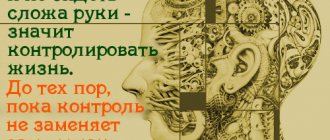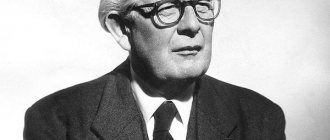What is thinking
Under thinking
in psychology they understand the process of modeling reality with the help of axiomatic provisions, which underlies human cognitive activity. Thinking is a generalized and indirect way of reflecting reality.
Many scientists and philosophers of different eras have emphasized that thought processes are a distinctive feature of human consciousness and are the very essence of man. “I think, therefore I exist,” said Descartes. Pascal said that man is a “thinking reed.”
The result of thinking is thought - concept, idea, meaning. Thought processes are contrasted with the lower forms of knowledge of reality, which are also characteristic of animals - sensation and perception.
The fact that thinking is the content and essence of human activity can be understood by the fact that it surrounds us literally everywhere. Thinking underlies all human science, art, politics, and religion. Thus, many human buildings have not only a utilitarian purpose, but also a symbolic one: the architecture of the building, its location, the nature of the lighting, even the materials from which it was built have a certain significance.
Thinking has one distinctive feature compared to other forms of cognition. With its help, you can obtain information about an object that cannot be perceived directly. This is achieved through thought processes such as deduction and analogy.
Types of thinking in psychology
There are several types of thinking in psychology.
All of them represent, as it were, different levels of representation of reality, different levels of abstraction
:
- Visual-effective thinking
. This is the primary level of understanding reality. In this case, thought processes are not yet separated from actions. It’s as if a person “thinks with his hands.” This type of thinking is predominant in children under three years of age. Thus, the child compares objects by placing them next to each other; synthesizes and analyzes, building a “house” from cubes and breaking toys; generalizes and classifies, arranging cubes by color, shape and size. In adults, such thinking does not disappear, but only fades into the background; it is used in cases where it is not possible to accurately predict events: when mastering unfamiliar equipment, rearranging furniture, etc. - Visual-figurative thinking
. This is a higher level of understanding of reality. Here, thought processes are ahead of actions, and not vice versa, as was the case in the previous case. To imagine an object and characterize its properties, a person no longer needs to touch it with his hands. This kind of thinking prevails in a child between four and seven years old. In adults, it manifests itself when, for example, they are planning an apartment renovation: a person can already imagine in advance what the room will look like, what color the wallpaper and ceiling will be, etc. - Verbal and logical thinking
. These are completely abstract thought processes that operate with concepts and logical constructs; such constructions sometimes may not have a visual image at all - such are, say, concepts like “honesty”, “cost”, etc. With the help of such thinking, a person determines the general patterns of various natural phenomena and generalizes visual material. It is clear that such thinking cannot be accessible to a small child, since at an early age a person has not yet accumulated a sufficient amount of figurative material.
Technologies for the development of thinking
Undoubtedly, to begin to develop, you do not need a lot of financial costs and any equipment as when playing sports, you only need a few free minutes a day (say, 15-30 minutes), consistency and effective use of the allocated time. Undoubtedly, the conditions for the development of thinking do not necessarily require special programs or only the indicated exercises; however, thinking simulators will help you rationally use your time. Their developers implement the latest research in this area for a comprehensive impact on each type of thinking. With this approach, everyone receives an even mental load, without depriving attention of that space of the brain that is rarely used in everyday work.
Types of thinking that need to be systematically developed:
- Boolean
- Abstract
- Creative
- Visually effective
- Visual-figurative
Functions and processes of thinking
Any type of thinking implements a certain set of processes that provide knowledge of the world around us.
:
- Comparison – comparison of objects and phenomena, highlighting their similarities and differences;
- Analysis – dividing an object or phenomenon into components;
- Synthesis is the opposite process to analysis, in which a whole is reconstructed from individual elements by establishing connections and relationships;
- Abstraction – highlighting one distinctive property of an object while ignoring all other, less significant ones;
- Generalization – discarding individual features to preserve and comprehend common ones, establishing significant connections.
At the same time, a small child needs to carry out these actions literally: disassemble, put objects, arrange them according to certain characteristics. It is enough for an adult to mentally imagine all these actions.
According to their functions, types of thinking in psychology are divided into reproductive, productive and creative. The first type is repetition of learned rules according to a given algorithm; This is how, for example, typical problems in textbooks are solved. Here, thought processes are aimed not at obtaining new knowledge, but at consolidating existing material. The second type is productive thinking, in which a person goes beyond existing knowledge and receives some new information; Moreover, they are new only for a given individual, but not for humanity. If the information obtained in this way is new for humanity, then the third type is involved here - creative thinking. In this case, thought processes acquire special complexity and structure.
Visual-figurative thinking is subject to a single algorithm. First, a person gives one judgment, then adds another to it, and on their basis makes a third judgment - a conclusion. It is the goal of thought processes.
Abstract thinking
How is it preferable for a person to think - concretely or abstractly? There is no clear answer to this question. Of course, in the real world there are no abstractions. What we see around us contains only concrete phenomena and objects. Abstractions take place only in the sphere of human thinking. For example, a specific birch tree grows under the window. It exists in reality. However, it is quite possible to abstract this birch with all the trees, calling it the abstract word “tree”. After this, the chain is not difficult to continue. Birch can well be called a plant, a living being, a material object, and simply an object. Each of the subsequent concepts is an even greater abstraction, that is, a generalization of a specific phenomenon.
There is nothing wrong with this type of thinking. Without it, it is impossible for a person to solve complex problems. It is in such cases that both abstract and concrete thinking are used.
However, sometimes certain problems may arise. If the volume of abstract and concrete thinking outweighs in favor of the first, it is considered that the person has mentally left the real world, moving into the imaginary one. And the latter, strictly speaking, exists only in his fantasies.
Concrete thinking is activated by people when they have clear information, knowledge and understanding of what is happening. What if all this is missing? Then abstract thinking turns on. At the same time, a person guesses, assumes and draws accurate conclusions.
Using abstract thinking, we do not take into account concrete details. Our discussions concern general concepts. In this case, a person considers the picture as a whole, without affecting the accuracy and specifics. Thanks to this, he manages to move away from dogmas and rules, considering the situation from different angles.
Abstract thinking is very useful when a person is at an intellectual impasse. In the absence of knowledge or information, he has to guess and reason. And if we abstract from specific details, then we can consider in the current situation something that was not visible before.
Types of thinking
Psychologists also distinguish different types of thinking. Usually each type divides people into two categories
:
- Logical - ethical
. Representatives of the first type reason in terms of patterns, rules, and logical connections. People from the second type think based on feelings, experiences, and mood. For the former, communication is an exchange of information, and for the latter, it is an exchange of energy and emotions. - Sensory – intuitive
. The first type involves concrete and practical thinking, its representatives are good at noticing details; they reason from the point of view of current events, understand the current situation. The second type is global, philosophical thinking, while it is theoretical and divorced from the current situation. - Decisive - judicious
. People of the first type make decisions quickly and can act in a tense environment; They often make mistakes, but quickly correct the situation and learn from their mistakes. People of the second type take a long time to make decisions, they are used to acting in a calm and comfortable environment, and avoid unnecessary actions. - Schizothymic - cyclothymic
. Schizothymic people are characterized by subtlety of feelings, selfishness, power, and the desire to be better than others. In ordinary life they show some signs of schizophrenia. Cyclothymics are prone to manic-depressive syndrome; they are irresponsible, carefree, cheerful and sociable. - "Changer" - "runner"
. People of the first type are oriented towards various actions, each time they do something new. But “runners” prefer to do one thing until they complete the task; they are conservative in everyday life, carefully choosing friends, communication, hobbies, and purchases. Such people do not adapt well to sudden changes. - Introverts - extroverts
. This division is well known: the thoughts of the former are directed primarily at their inner world, and the thoughts of the latter are directed primarily at the external world. The former are sensitive, reserved and reasonable, while the latter are active, sociable and open. - Internals - externals
. People of the first type believe that everything that happens to them depends only on their personal qualities. They blame only themselves for all adversity, and rejoice in success as their achievements. People of the second type are sure that everything around them happens due to external circumstances: the actions of other people, chance, “fate,” etc. - Positivism - negativism
. People of the first type see in a situation primarily the qualities that it contains. They reason in affirmative constructions: “What is the weather now? “It’s good, it’s warm outside.” Negativists first notice in the same situations qualities that are absent in them, and reason with negative constructions: “What is the weather now? “Not bad, it’s not cold outside.”
In each of these types, mental activity has its own specifics. In particular, the ability to make true and false conclusions depends on this. However, overly pronounced representatives of either side tend to constantly make logical errors. These are, say, externals and internals. They often cannot objectively assess the situation and are guided by the simplest initial attitudes: “This happened because of me” or “This happened because of others,” when in fact the situation occurred due to a confluence of many circumstances. And it contains both part of the fault of the person himself and part of the fault of the environment.
Since we are talking about logical errors, it is worth considering a type of thinking that is initially erroneous. This is the so-called predicative thinking, which psychologists contrast with logical thinking. A predicate, or predicate, is what is said about an object, its quality or action that is relevant at the time of utterance. “Predicativism” is a type of reason when a person identifies dissimilar objects due to the same predicate.
Example: “Muslims do not eat pork. Vasya doesn't eat pork. Therefore, Vasya is a Muslim.” The error in reasoning is obvious. The correct reasoning in this case would be: “Muslims do not eat pork. Ahmet is a Muslim. Therefore, Akhmet does not eat pork.” The predicate is not an essential feature of the subject; it is relevant only at the time of utterance; therefore, the same predicative can be applied to many unrelated objects. Not only Muslims do not eat pork, but also vegetarians (they generally refuse meat), the poor (they simply do not have money for pork), glass bottles (these are inanimate objects, they cannot eat), etc.
Despite its initial fallibility, predicative thinking is common to many people. This is precisely the irrational type of reason on which political ideology and propaganda, religion, advertising and marketing are based. Examples of “predicativism” can easily be found in advertising slogans: “All successful people use this brand of shampoo!” — the consumer’s reaction is expected: “I use this brand of shampoo, therefore, I am a successful person.” Such a consumer will continue to use shampoo of this brand in order to maintain the status of a “successful person.” “Predictive people” are thus very easy to control, they are suggestible, and they can be easily deceived.
It was precisely this predicative type of reason that became the cause of the medieval “witch hunt,” when sorcerers and witches were found by external signs: red hair color, special clothing, voice, etc. (all these are signs that are insignificant for an object with the status of “witch.” "). It also gave rise to nationalist, racist theories, religious intolerance, and clashes between different youth subcultures. Nowadays, the predicative mind rules the so-called consumer society. Everyone wants to be like successful people, “cool”, rich and famous, while being similar purely in appearance. The “typical consumer” does not understand that Pavel Durov is successful not because he has a lot of money, but because he is a talented programmer, the developer of several large projects (and only because of this he has a lot of money). Predicative reason gives rise to such a phenomenon as envy, while the person himself does not understand what exactly he is envious of.










